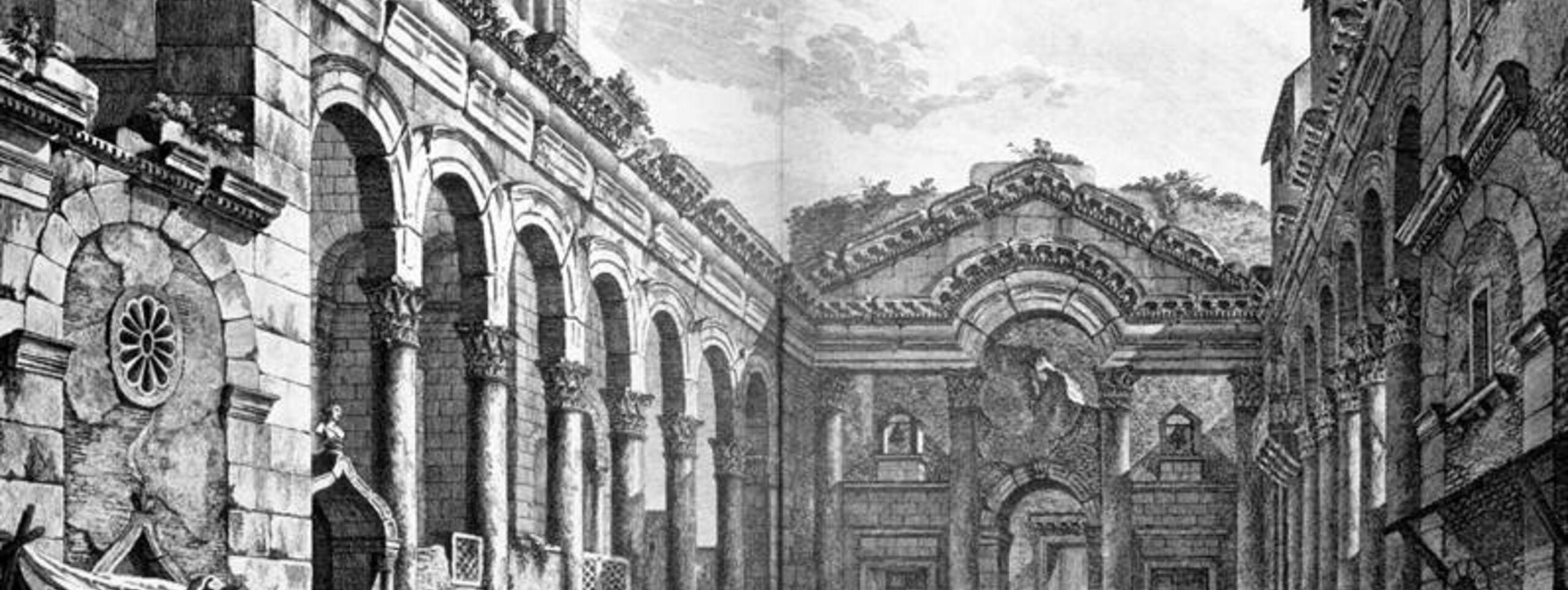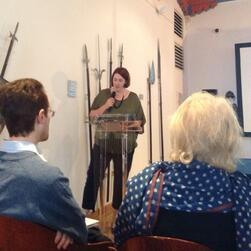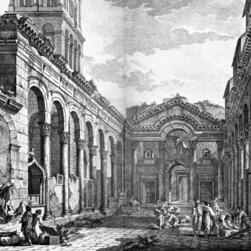Our Catalogue Editor Dr Fran Sands recently travelled to Split, Croatia, for a conference on the influence of Diocletian’s Palace. Here she discusses her trip.
It was towards the end of his Grand Tour in 1757 that Robert Adam applied to the Venetian authorities for permission to visit Spalatro (now Split in Croatia). Recognising the power of archaeological publication, his intention was to explore the ruins of Diocletian’s Palace, taking with him a band of skilled draughtsmen in order that he could record his findings during a five-week visit. Following his return to London, Adam enhanced his status as an expert on antique domestic architecture through his publication of ‘The Ruins of the Palace of the Emperor Diocletian at Spalatro in Dalmatia’ (London, 1764). Although Diocletian’s Palace had been visited by the likes of Palladio and Serlio, Adam’s work comprised the first scholarly articulation of these important ruins, affording him an opportunity to make his mark and generate publicity for the Adam brand. It also functioned as a pattern book for Adam’s architectural style, giving academic credence to creative choice.
2014 marks the 250th anniversary of Adam’s pioneering publication on Diocletian’s Palace, and to celebrate this milestone the Institute of Art History – Centre Cvito Fisković Split, hosted a three-day conference (27-29 November 2014) at Split City Museum entitled ‘Diocletian’s Palace in the works of Adam, Clérisseau and Cassas’. The event was financed by the Croatian Ministry of Science, Education and Sport and the City of Split, and also inaugurated an important installation research project, ‘Dalmatia – a destination of the European Grand Tour in the 18th and 19th century’ (2014-2017) which will be led by the conference organiser, Dr Ana Šverko of the Croatian Institute of Art History, under the aegis of the Croatian Science Foundation.
17 scholars from 8 different countries presented papers on the influence of Diocletian’s Palace, and it was a great honour to be counted among that number. The speakers included Prof. Stephen Caffey of Texas A&M University; Prof. Heather Hyde Minor of the University of Illinois; Dr Ivan Mirnik and Dr Ante Rendić-Miočević, formerly of the Zagreb Archaeological Museum; Prof. John Pinto of Princeton University; Dr Colin Thom, Senior Historian with the Survey of London at UCL; and Dr Elke Katharina Wittich of the University of Applied Sciences, Hamburg. It was my pleasure to introduce and moderate the first group of speakers, and to lead the following discussion panel. My paper was delivered during the second day of the conference, and was entitled ‘Reconstructed and in Ruins: the influence of Diocletian’s Palace within the drawings of Robert Adam’, giving examples of graphic evidence from among the 9,000-strong Adam drawings collection at Sir John Soane’s Museum for motifs and arrangements influenced by Diocletian’s Palace in Split. The full conference proceedings will be published by the Centre Cvito Fisković during 2015.
A week prior to this important conference Dr Šverko had visited me at the Soane Museum to view a selection of Adam’s Grand Tour drawings, as well as Soane’s Royal Academy lecture drawings which reproduce a number of Adam’s published illustrations of Diocletian’s Palace. This had been a lovely opportunity to meet Ana, and her companion, Flora Turner-Vučetić, consultant to ‘Dalmatia – a destination of the European Grand Tour in the 18th and 19th century’, and former Cultural Consultant at the Croatian Embassy in London. I was fortunate enough to travel with Mrs Turner, and during our flight we bumped into an acquaintance of hers, the rising Croatian operatic soprano Lana Kos, who was travelling to Split to sing the leading role of Violetta in Giuseppe Verdi's ‘La Traviata’. As the opening performance was scheduled after our first day at the conference we decided to attend, and I am extremely grateful to Dr Joško Belamaric, Director of the Centre Cvito Fisković Split, and Trustee of Croatia’s National Theatre in Split, for arranging our tickets for this excellent performance at such short notice. I found that this was only one of many examples of extreme generosity on the part of my kind hosts in Croatia, which made my visit to beautiful Split all the more enjoyable.
Dr Frances Sands, Catalogue Editor (Adam drawings project), has been working on a project to make 8,000 drawings from the Adam collection available to view online.
As part of the Museum’s programme of digitization and improved access to collections the Adam drawings will also be amongst the 50,000 – 60,000 works of art, books and drawings, plus the Soane Archive to be transferred into the Collections Index+ Collections Management System (CMS) that will for the first time ever allow the Museum to store and sort records of all the items in the Museum’s collection. This has been made possible with thanks to funding from the HLF and an additional year’s funding by the Arts Council England’s Designation Development Fund for the collections information to become available to the public.


